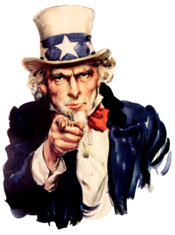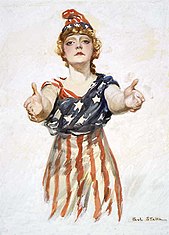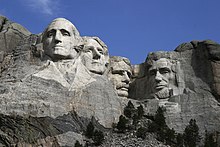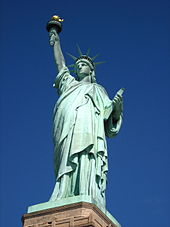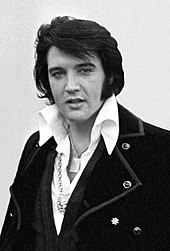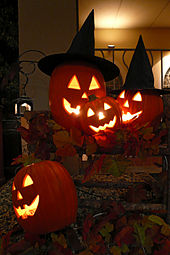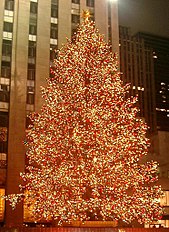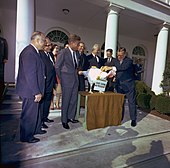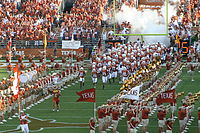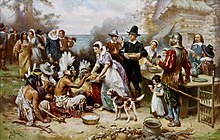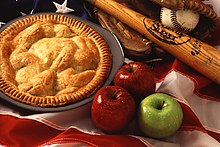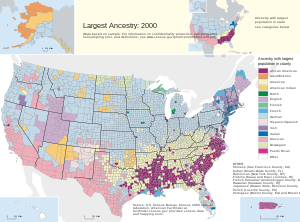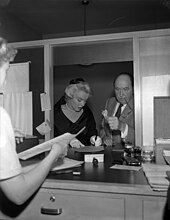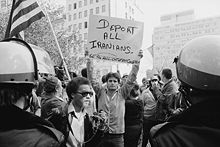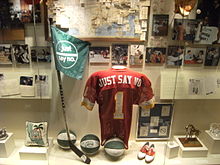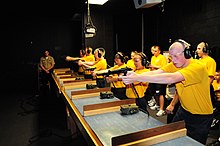The culture of the United States of America is primarily of Western culture (European) origin and form, but is influenced by a multicultural ethos that includes African, Native American, Asian, Polynesian, and Latin American people and their cultures. It also has its own social and cultural characteristics, such as dialect, music, arts, social habits, cuisine, and folklore. The United States of America is an ethnically and racially diverse country as a result of large-scale migration from many countries throughout its history. Many American cultural elements, especially from popular culture, have spread across the globe through modern mass media.
Origins, development, and spread
The European roots of the United States are in the English settlers of colonial America during British rule.
The varieties of English people as opposed to the other peoples in the
British Isles were the overwhelming majority ethnic group in the 17th
century (population of the colonies in 1700 250,000) and were 47.9% of
percent of the total population of 3. 9 million. They constituted 60%
of the whites at the first census in 1790 (%, 3.5 Welsh, 8.5 Scotch
Irish, 4.3 Scots, 4.7 Southern Irish, 7.2 German, 2.7 Dutch, 1.7 French
and .2 Swedish), The American Revolution, Colin Bonwick, 1991, p. 254.
The English ethnic group contributed the major cultural and social
mindset and attitudes that evolved into the American character. Of the
total population in each colony they numbered from 30% in Pennsylvania
to 85% in Massachusetts, Becoming America, Jon Butler, 2000, pp. 9–11.
Large non-English immigrant populations from the 1720s to 1775, such as
the Germans (100,000 or more), Scotch Irish (250,000), added enriched
and modified the English cultural substrate, The Encyclopedia of
Colonial and Revolutionary America, Ed. John Mack Faragher, 1990,
pp. 200–202. The religious outlook was some versions of Protestantism
(1.6% of the population were English, German and Irish Catholics ).
The British colonies inherited the English language, legal system, and British culture, which was the majority cultural heritage. Parts of what are now the United States were colonized by France, Spain, the Netherlands, Sweden, Denmark, Russia, and Japan (Northern Mariana Islands and briefly Guam).[2]
Though eventually overtaken by British or American territorial
expansion, the longer they lasted the more these earlier colonial
societies contributed to modern-day culture, including place names,
architecture, religion, language, and food.
Jeffersonian democracy was a foundational American cultural innovation, which is still a core part of the country's identity. Thomas Jefferson's Notes on the State of Virginia
was perhaps the first influential domestic cultural critique by an
American and was written in reaction to the views of some influential
Europeans that America's native flora, fauna, including humans, were degenerate.
Major cultural influences have been brought by historical immigration, especially from Germany in much of the country, Ireland and Italy in the Northeast, Japan in Hawaii. Latin American culture is especially pronounced in former Spanish areas but has also been introduced by immigration, as has Asian American cultures (especially on the West Coast). Forced migration during the Atlantic slave trade, followed by liberation won in the American Civil War created African-American culture which pervades the South and other areas receiving internal immigrants during the Great Migrations.
Blending Southern and traditional African culture to some degree, this
uniquely American culture has its own dialect; has contributed
significant innovation in music, dance, and fashion; embraced a struggle
by many African-Americans for political and economic equality; and is
associated with significant populations of African-American Muslims and Christians in "Black churches". Rap
and music videos featuring African-American urban street culture have
appeared in countries and melded with local performance cultures
worldwide.
Though many mainland Native American
tribes and nations were overpowered by European colonists and American
territorial expansion, but even in the areas they were pushed out of
left cultural influences such as place names, knowledge about New World crops; cultural appropriation
and the history military rivalry resulted in Native American-themed
sports mascots. Native culture remains strong in areas with large
undisturbed or relocated populations, including traditional government
and communal organization of property now legally managed by Indian reservations (large reservations are mostly in the West, especially Arizona and South Dakota). The fate of native culture after contact with Europeans is quite varied. For example, Taíno culture in U.S. Caribbean territories is nearly extinct and like most Native American languages, the Taíno language is no longer spoken. In contrast the Hawaiian language and culture of the Native Hawaiians has survived in Hawaii and mixed with that of immigrants from the mainland U.S. (starting before the 1898 annexation) and to some degree Japanese immigrants. It occasionally influences mainstream American culture with notable exports like surfing and Hawaiian shirts.
Most languages native to what is now U.S. territory have gone extinct,
and the economic and mainstream cultural dominance of English threatens
the surviving ones in most places. The most common native languages
include Samoan, Hawaiian, Navajo language, Cherokee, Sioux, and a spectrum of Inuit languages. (See Indigenous languages of the Americas for a fuller listing, plus Chamorro, and Carolinian in the Pacific territories.) Ethnic Samoans are a majority in American Samoa; Chamorro are still the largest ethnic group in Guam (though a minority), and along with Refaluwasch are smaller minorities in the Northern Mariana Islands.
American culture includes both conservative and liberal elements,
scientific and religious competitiveness, political structures, risk
taking and free expression, materialist and moral elements. Despite
certain consistent ideological principles (e.g. individualism, egalitarianism, and faith in freedom and democracy),
American culture has a variety of expressions due to its geographical
scale and demographic diversity. The flexibility of U.S. culture and its
highly symbolic nature lead some researchers to categorize American
culture as a mythic identity; others see it as American exceptionalism.
The United States has traditionally been thought of as a melting pot, with immigrants contributing to but eventually assimilating
with mainstream American culture. However, beginning in the 1960s and
continuing on in the present day, the country trends towards cultural diversity, pluralism, and the image of a salad bowl instead. Throughout the country's history, certain subcultures (whether based on ethnicity or other commonality, such as the gay village)
have dominated certain neighborhoods, only partially melded with the
broader culture. Due to the extent of American culture, there are many
integrated but unique social subcultures
within the United States, some not tied to any particular geography.
The cultural affiliations an individual in the United States may have
commonly depend on social class, political orientation and a multitude of demographic characteristics such as religious background, occupation, and ethnic group membership.
Mass media
promote cross-cultural diffusion. Some subcultures have national media
exposure with dedicated television channels and crossover with
mainstream media (such as Latin, African American, and LGBT culture,
though there are many niche channels). Some communities have local
broadcast or paper publications that carry content from a specific
culture, such as native radio stations or Chinese-language newspapers in
Chinatowns. Almost every subculture has a presence on the World Wide Web and social media.
Military history has influenced American culture and its worldwide reach in several ways. German cuisine became stigmatized by World War I; but in contrast the end of World War II
resulted in cross-fertilization of American and Japanese business
techniques during reconstruction and occupation, and brought home troops
with an increased taste for Italian dishes. Wars have also forced
progress on equal rights for women and racial minorities, as these
groups proved their till-then unrealized potential either in industry
while men were off fighting, or by serving in the military honorably and
effectively. The American Civil War highlighted differences in culture (including attitudes toward racism) between the Southern United States
and the North. Though the issue of slavery was settled by the war,
racism and discrimination persisted and were supported by laws in some
Southern states. Combined with determined civil rights activism, later
wars resulted in profound changes in social norms, including
desegregation, more intermixing of Black and White cultures, and more
egalitarian social roles for men and women compared to countries that
have not undergone similar shifts. Modern display of the Confederate flag and removal of Confederate monuments and memorials
remain controversial cultural and political issues, though many
elements of proud Southern identity and culture such as hospitality,
drawl, and comfort food have nothing to do with racial division. Some
differences in modern cultural tendencies fall along
liberal-conservative political lines, with people on both sides of that
increasingly self-segregating.
The post-WWII economic and military power of the United States
(not to mention its large, relatively unified population) also helped it
become more of an exporter of its own culture and values compared to
its initial tendency to import of European culture (especially in its
early, largely rural decades). The United States has also administered
now-foreign territories for many years, creating opportunities for
cultural intermingling among many government employees and military
personnel. The longest stays have included the Philippines (1898–1946), Panama Canal Zone (1903–1979), Haiti (1915-1934,), the Dominican Republic (1916-1924), and various Japanese islands and the Trust Territory of the Pacific Islands for decades after WWII.
Colonists from the United States formed the now-independent country of Liberia,
which inherited a considerable amount of American culture and values.
Given its proximity, relatively free movement over the border, the
highly integrated North American economy, strong military alliance,
shared origins in British colonialism, and a common language, the
English-speaking culture of Canada
is strongly influenced by that of the United States. Some Canadians
resist the dominance of the United States includes requirements for
domestically produced mass media, though especially since the Hollywood North
phenomenon began in the 1980s, Canada also exports entertainment to the
United States. American movies may have made the biggest impact of all
American exports on popular culture worldwide.
Regional variations
Semi-distinct cultural regions of the United States include New England, the Mid-Atlantic states, the Southern United States, the Midwestern United States and the Western United States—an area that can be further subdivided, on the basis of the local culture into the Pacific States and the Mountain States.
The western coast of the continental United States consisting of California, Oregon, and the state of Washington is also sometimes referred to as the Left Coast, indicating its left-leaning political orientation and tendency towards social liberalism.
Southern United States are informally called "the Bible Belt" due to socially conservative evangelical Protestantism, which is a significant part of the region's culture and Christian church attendance across the denominations is generally higher there than the nation's average. This region is usually contrasted with the mainline Protestantism and Catholicism of the northeastern United States, the religiously diverse Midwest and Great Lakes, the Mormon Corridor in Utah and southern Idaho, and the relatively secular western United States. The percentage of non-religious people is the highest in the northeastern state of Vermont at 34%, compared to the Bible Belt state of Alabama, where it is 6%.
Strong cultural differences have a long history in the U.S. with
the southern slave society in the antebellum period serving as a prime
example. Not only social, but also economic tensions between the
Northern and Southern states were so severe that they eventually caused
the South to declare itself an independent nation, the Confederate States of America; thus initiating the American Civil War.
Fischer's theory
The Statue of Liberty in New York City,
is an important cultural symbol in the United States, and the values
that it symbolizes—the virtues of freedom and liberty—are likewise
integral to United States culture
David Hackett Fischer theorizes that the United States is made up today of four distinct regional cultures. The book's focus is on the folkways of four groups of settlers from the British Isles
that emigrated from distinct regions of Britain and Ireland to the
British American colonies during the 17th and 18th centuries. Fischer's
thesis is that the culture and folkways of each of these groups
persisted, albeit with some modification over time, providing the basis
for the four modern regional cultures of the United States.
According to Fischer, the foundation of American culture was formed from four mass migrations from four different regions of the British Isles by four distinct socio-religious groups. New England's earliest settlement period occurred between 1629 and 1640 when Puritans, mostly from East Anglia in England, settled there, forming the New England regional culture. The next mass migration was of southern English cavaliers and their working class English domestic servants to the Chesapeake Bay region between 1640 and 1675. This facilitated the development of the Southern American culture.
Then (between 1675 and 1725), thousands of English and Welsh Quakers, led by William Penn, settled in the Delaware Valley
followed by large numbers of German Lutherans. This settlement resulted
in the formation of what is today considered the "General American"
culture, although, according to Fischer, it is really just a regional
American culture, even if it does today encompass most of the U.S. from
the mid-Atlantic states to the Pacific Coast. Finally, Scotch-Irish,
English and Scottish settlers from the borderlands of Britain and
Ireland migrated to Appalachia between 1717 and 1775. They formed the regional culture of the Upland South, which has since spread west to such areas as West Texas and parts of the U.S. Southwest.
Fischer suggests that the U.S. today is not a country with one
General American culture and three or more regional sub-cultures. He
asserts that the country is composed of just regional cultures, and that
understanding that helps one to understand many things about modern
American life. Fischer also makes the point that the development of
these regional cultures derived not only from where exactly the settlers
first came, but when they came. Fischer asserts that during different
periods of time, a population of people will have very distinct beliefs,
fears, hopes and prejudices, and that various groups of settlers
brought these feelings to the New World where they more or less froze in
time in America, even if they eventually changed in their place of
origin.
Woodard's theory
Continuing the work of Fischer, Colin Woodard, in his book American Nations,
claims an existence of eleven rival regional cultures in North America,
based on the cultural characteristics of the original settlers of these
regions. These regions are: 'Yankeedom', 'New Netherland', 'the
Midlands', 'Tidewater', 'Greater Appalachia', 'the Deep South', 'New
France', 'El Norte', 'the Left Coast', 'the Far West', and 'First
Nation'.
According to Woodard, these regions cross and disregard formal
state or country borders. For example, he compares the Mexico—U.S.
border with the Berlin wall,
saying that "El Norte in some ways resembles Germany during the Cold
War: two peoples with a common culture separated by a large wall."
Language
Tree map of languages in the US
Although the United States has no official language at the federal level, 28 states have passed legislation making English the official language and it is considered to be the de facto national language. According to the 2000 U.S. Census,
more than 97% of Americans can speak English well, and for 81% it is
the only language spoken at home. More than 300 languages besides
English have native speakers in the United States—some of which are
spoken by the indigenous peoples (about 150 living languages) and others imported by immigrants.
Spanish has official status in the commonwealth of Puerto Rico and the state of New Mexico; Spanish is the primary spoken language in Puerto Rico and various smaller linguistic enclaves.
According to the 2000 census, there are nearly 30 million native
speakers of Spanish in the United States. Bilingual speakers may use
both English and Spanish reasonably well but code-switch according to their dialog partner or context. Some refer to this phenomenon as Spanglish.
Indigenous languages of the United States include the Native American languages, which are spoken on the country's numerous Indian reservations and Native American cultural events such as pow wows; Hawaiian, which has official status in the state of Hawaii; Chamorro, which has official status in the commonwealths of Guam and the Northern Mariana Islands; Carolinian, which has official status in the commonwealth of the Northern Mariana Islands; and Samoan, which has official status in the commonwealth of American Samoa. American Sign Language, used mainly by the deaf, is also native to the country.
The national dialect is known as American English,
which itself consists of numerous regional dialects but has some shared
unifying features that distinguish it from other national varieties of
English. There are four large dialect regions in the United States—the North, the Midland, the South, and the West—and several smaller dialect regions such as those of New York City, Philadelphia, and Boston. A standard dialect called "General American" (analogous in some respects to the received pronunciation elsewhere in the English-speaking world),
lacking the distinctive noticeable features of any particular region,
is believed by some to exist as well; it is sometimes regionally
associated with the vaguely-defined "Midwest".
Native language statistics for the United States
The following information is an estimation as actual statistics constantly vary.
According to the CIA, the following is the percentage of total population's native languages in the United States:
- English (82.1%)
- Spanish (10.7%)
- Other Indo-European languages (3.8%)
- Other Asian or Pacific Islander languages (2.7%)
- Other languages (0.7%)
Literature
Herman Melville was a novelist of the American Renaissance period
Mark Twain is regarded as among the greatest writers in American history
The right to freedom of expression in the American constitution can be traced to German immigrant John Peter Zenger and his legal fight to make truthful publications in the Colonies a protected legal right, ultimately paving the way for the protected rights of American authors.
In the eighteenth and early nineteenth centuries, American art
and literature took most of its cues from Europe. During its early
history, America was a series of British colonies
on the eastern coast of the present-day United States. Therefore, its
literary tradition begins as linked to the broader tradition of English literature.
However, unique American characteristics and the breadth of its
production usually now cause it to be considered a separate path and
tradition.
America's first internationally popular writers were James Fenimore Cooper and Washington Irving
in the early nineteenth century. They painted an American literary
landscape full of humor and adventure. These were followed by Nathaniel Hawthorne, Edgar Allan Poe, Herman Melville, Ralph Waldo Emerson, Henry Wadsworth Longfellow and Henry David Thoreau who established a distinctive American literary voice in the middle of the nineteenth century.
Stephen King is an author of horror whose books have sold more than 350 million copies
Mark Twain, Henry James, and poet Walt Whitman were major figures in the century's second half; Emily Dickinson,
virtually unknown during her lifetime, would be recognized as America's
other essential poet. Eleven U.S. citizens have won the Nobel Prize in Literature, including John Steinbeck, William Faulkner, Eugene O'Neill, Pearl S. Buck, T. S. Eliot and Sinclair Lewis. Ernest Hemingway, the 1954 Nobel laureate, is often named as one of the most influential writers of the twentieth century.
Ernest Hemingway won the Nobel Prize in Literature in 1954
A work seen as capturing fundamental aspects of the national experience and character—such as Herman Melville's Moby-Dick (1851), Twain's The Adventures of Huckleberry Finn (1885), F. Scott Fitzgerald's The Great Gatsby (1925), and Harper Lee's To Kill a Mockingbird (1960)— may be dubbed the "Great American Novel". Popular literary genres such as the Western and hardboiled crime fiction were developed in the United States.
Art
The iconic dome of the Capitol Building, home to the United States Congress
In the late eighteenth and early nineteenth centuries, American
artists primarily painted landscapes and portraits in a realistic style
or that which looked to Europe for answers on technique: for example, John Singleton Copley was born in Boston, but most of his portraiture for which he is famous follow the trends of British painters like Thomas Gainsborough
and the transitional period between Rococo and Neoclassicalism. The
later eighteenth century was a time when the United States was just an
infant as a nation and was far away from the phenomenon where artists
would receive training as craftsmen by apprenticeship and later seeking a
fortune as a professional, ideally getting a patron: Many artists
benefited from the patronage of Grand Tourists eager to procure mementos
of their travels. There were no temples of Rome or grand nobility to be
found in the Thirteen Colonies. Later developments of the 19th century
brought America one of its earliest native home grown movements, like
the Hudson River School and portrait artists with a unique American flavor like Winslow Homer.
A parallel development taking shape in rural America was the American craft movement, which began as a reaction to the Industrial Revolution.
As the nation grew wealthier, it had patrons able to buy the works of
European painters and attract foreign talent willing to teach methods
and techniques from Europe to willing students as well as artists
themselves; photography became a very popular medium for both journalism
and in time as a medium in its own right with America having a great
deal of open spaces of natural beauty and growing cities in the East
teeming with new arrivals and new buildings. Museums in Chicago, New York, Boston, Philadelphia, and Washington, D.C. began to have a booming business in acquisitions, competing for works as diverse as the then more recent work of the Impressionists to pieces from Ancient Egypt,
all of which captured the public imaginations and further influenced
fashion and architecture. Developments in modern art in Europe came to
America from exhibitions in New York City such as the Armory Show
in 1913. After World War II, New York emerged as a center of the art
world. Painting in the United States today covers a vast range of
styles. American painting includes works by Jackson Pollock, John Singer Sargent, Georgia O'Keeffe, and Norman Rockwell, among many others.
Architecture
The Art Deco architectural style of the Empire State Building was typical of such buildings of the period
Architecture in the United States is regionally diverse and has been
shaped by many external forces, not only English. U.S. architecture can
therefore be said to be eclectic, something unsurprising in such a
multicultural society.
In the absence of a single large-scale architectural influence from
indigenous peoples such as those in Mexico or Peru, generations of
designers have incorporated influences from around the world. Currently,
the overriding theme of American Architecture is modernity, as manifest in the skyscrapers of the 20th century, with domestic and residential architecture greatly varying according to local tastes and climate.
Early Neoclassicism
accompanied the Founding Father's idealization of European
Enlightenment, making it the predominant architectural style for public
buildings and large manors. However, in recent years, suburbanization
and mass migration to the Sun Belt has allowed architecture to reflect a Mediterranean style as well.
Theater
The Palace Theatre is part of Broadway, one of the highest levels of commercial theatre in the English-speaking world
Frank Sinatra is awarded the Presidential Medal of Freedom by President Ronald Reagan
Theater
of the United States is based in the Western tradition and did not take
on a unique dramatic identity until the emergence of Eugene O'Neill
in the early twentieth century, now considered by many to be the father
of American drama. O'Neill is a four-time winner of the Pulitzer Prize for drama and the only American playwright to win the Nobel Prize for literature. After O'Neill, American drama came of age and flourished with the likes of Arthur Miller, Tennessee Williams, Lillian Hellman, William Inge, and Clifford Odets
during the first half of the twentieth century. After this fertile
period, American theater broke new ground, artistically, with the
absurdist forms of Edward Albee in the 1960s.
Elvis Presley was an American singer regarded as one of the most significant cultural icons of the 20th century
The Singer Beyoncé has sold over 100 million records worldwide, making her one of the world's best-selling music artists. Here she is pictured with husband and rapper Jay-Z
Actor James Dean is a cultural icon of teenage disillusionment
Louis Armstrong was a jazz composer, vocalist and trumpeter
Fred Astaire was an influential dance choreographer and actor
Thomas Edison and his early phonograph. Edison was credited for inventing many devices, including the lightbulb
Social commentary has also been a preoccupation of American theater,
often addressing issues not discussed in the mainstream. Writers such as
Lorraine Hansbury, August Wilson, David Mamet and Tony Kushner have all won Pulitzer Prizes for their polemical plays on American society. The United States is also the home and largest exporter of modern musical theater, producing such musical talents as Rodgers and Hammerstein, Lerner and Loewe, Cole Porter, Irving Berlin, Leonard Bernstein, George and Ira Gershwin, Kander and Ebb, and Stephen Sondheim. Broadway is one of the largest theater communities in the world and is the epicenter of American commercial theater.
Music
American music styles and influences (such as rock and roll, jazz, rock, techno, soul, country, hip-hop, blues)
and music based on them can be heard all over the world. Music in the
U.S. is diverse. It includes African-American influence in the 20th
century. The first half of this century is famous for jazz, introduced
by African-Americans. According to music journalist Robert Christgau, "pop music is more African than any other facet of American culture."
Dance
The United States is represented by various genres of dance, from
ballet to hip-hop and folk. Dances of the upper classes of earlier ages
of Europe were known in the US, like the minuet,
but it must be remembered that in its earliest years the USA did not
have a formidable and fixed class of the extremely wealthy dictating the
tastes of the masses and all else was just lowbrow and common. By and
large, the USA was settled repeatedly by people who had no connection to
royalty and were either very poor or bound for slavery. The folkways of
the British Isles in the earliest years were predominant, as it was
with music, and on the plantations black slaves handed down a form of
dance that was rhythmic, flat footed, and had greater movement of the
upper body where control was decidedly not emphasized. Here is where the
square dance and cakewalk were born in their earliest incarnations.
Later groups also brought new ideas that were completely unknown
in aristocratic courts of Europe, Irish immigrants brought with them
their Irish step dancing which required lots of hopping and tapping of the feet, Eastern Europeans brought the polka,
and Spanish speakers from the Caribbean brought dances that required
much closer contact and twirling of the female with shaking of the hips.
In time, this would give birth to dances like the jitterbug, tap dance, the Charleston, and rumba.
Cinema
The cinema of the United States,
often generally referred to as Hollywood, has had a profound effect on
cinema across the world since the early twentieth century. While the Lumiere Brothers
are generally credited with the birth of modern cinema, it is American
cinema that has emerged as the most dominant force in the industry. Its
history can be separated into four main periods: the silent film era, classical Hollywood cinema, New Hollywood, and the contemporary period. Actor James Dean,
who appeared in films during the classical Hollywood era until his
untimely death, is widely regarded as an American cultural icon of
teenage disillusionment.
Astronomer Carl Sagan helped popularize science to many
American independent cinema was revitalized in the late 1980s and
early 1990s when another new generation of moviemakers, including Spike Lee, Steven Soderbergh, Kevin Smith, and Quentin Tarantino made movies like, respectively: Do the Right Thing; Sex, Lies, and Videotape; Clerks; and Reservoir Dogs.
In terms of directing, screenwriting, editing, and other elements,
these movies were innovative and often irreverent, playing with and
contradicting the conventions of Hollywood movies. Furthermore, their
considerable financial successes and crossover into popular culture
reestablished the commercial viability of independent film. Since then,
the independent film industry has become more clearly defined and more
influential in American cinema. Many of the major studios have
capitalized on this by developing subsidiaries to produce similar films;
for example Fox Searchlight Pictures.
To a lesser degree in the early 21st century, film types that
were previously considered to have only a minor presence in the
mainstream movie market began to arise as more potent American box
office draws. These include foreign-language films such as Crouching Tiger, Hidden Dragon, Baahubali 2 and Hero and documentary films such as Super Size Me, March of the Penguins, and Michael Moore's Bowling for Columbine and Fahrenheit 9/11.
Broadcasting
Television is a major mass media of the United States. Household ownership of television sets in the country is 96.7%,
and the majority of households have more than one set. The peak
ownership percentage of households with at least one television set
occurred during the 1996–97 season, with 98.4% ownership. As a whole, the television networks of the United States are the largest and most syndicated in the world.
As of August 2013, approximately 114,200,000 American households own at least one television set.
Due to a recent surge in the number and popularity of critically
acclaimed television series, many critics have said that American
television is currently enjoying a golden age.
American family watching TV, 1958
Science and technology
The Washington Post on Monday, July 21, 1969 stating "'The Eagle Has Landed'—Two Men Walk on the Moon"
There is a regard for scientific advancement and technological
innovation in American culture, resulting in the flow of many modern
innovations. The great American inventors include Robert Fulton (the steamboat); Samuel Morse (the telegraph); Eli Whitney (the cotton gin, interchangeable parts); Cyrus McCormick (the reaper); and Thomas Edison
(with more than a thousand inventions credited to his name). Most of
the new technological innovations over the 20th and 21st centuries were
either first invented in the United States, first widely adopted by
Americans, or both. Examples include the lightbulb, the airplane, the transistor, the atomic bomb, nuclear power, the personal computer, the iPod, video games, online shopping, and the development of the Internet.
A replica of the first working transistor
This propensity for application of scientific ideas continued
throughout the 20th century with innovations that held strong
international benefits. The twentieth century saw the arrival of the Space Age, the Information Age, and a renaissance in the health sciences. This culminated in cultural milestones such as the Apollo moon landings, the creation of the Personal Computer, and the sequencing effort called the Human Genome Project.
Throughout its history, American culture has made significant
gains through the open immigration of accomplished scientists.
Accomplished scientists include: Scottish-American scientist Alexander Graham Bell, who developed and patented the telephone and other devices; German scientist Charles Steinmetz, who developed new alternating-current electrical systems in 1889; Russian scientist Vladimir Zworykin, who invented the motion camera in 1919; Serb scientist Nikola Tesla who patented a brushless electrical induction motor based on rotating magnetic fields in 1888. With the rise of the Nazi
party in Germany, a large number of Jewish scientists fled Germany and
immigrated to the country, including theoretical physicist Albert Einstein in 1933.
In the years during and following WWII, several innovative scientists immigrated to the U.S. from Europe, such as Enrico Fermi, who came from Italy in 1938 and led the work that produced the world's first self-sustaining nuclear chain reaction. Post-war Europe saw many of its scientists, such as rocket scientist Wernher von Braun, recruited by the United States as part of Operation Paperclip.
Education
Higher education in the US by race as of 2003
Education in the United States is and has historically been provided
mainly by government. Control and funding come from three levels: federal, state, and local.
School attendance is mandatory and nearly universal at the elementary
and high school levels (often known outside the United States as the
primary and secondary levels).
Students have the options of having their education held in public schools, private schools, or home school. In most public and private schools, education is divided into three levels: elementary school, junior high school (also often called middle school), and high school. In almost all schools at these levels, children are divided by age groups into grades. Post-secondary education, better known as "college" in the United States, is generally governed separately from the elementary and high school system.
In the year 2000, there were 76.6 million students enrolled in schools from kindergarten through graduate schools.
Of these, 72 percent aged 12 to 17 were judged academically "on track"
for their age (enrolled in school at or above grade level). Of those
enrolled in compulsory education, 5.2 million (10.4 percent) were
attending private schools. Among the country's adult population, over 85
percent have completed high school and 27 percent have received a bachelor's degree or higher.
Religion
Completed in 1716, San Antonio Missions National Historical Park is one of numerous surviving colonial Spanish missions in the United States. These were primarily used to convert the Native Americans to Roman Catholicism
Among developed countries, the U.S. is one of the most religious in terms of its demographics. According to a 2002 study by the Pew Global Attitudes Project,
the U.S. was the only developed nation in the survey where a majority
of citizens reported that religion played a "very important" role in
their lives, an opinion similar to that found in Latin America. Today, governments at the national, state, and local levels are secular institutions, with what is often called the "separation of church and state".
Although participation in organized religion has been diminishing, the public life and popular culture
of the United States incorporates many Christian ideals specifically
about redemption, salvation, conscience, and morality. Examples are
popular culture obsessions with confession and forgiveness, which
extends from reality television to twelve-step meetings. Americans expect public figures to confess and have public penitence for any sins or moral wrongdoings they may have caused. According to Salon, examples of inadequate public penitence may include the scandals and fallout regarding Tiger Woods, Alex Rodriguez, Mel Gibson, Larry Craig, and Lance Armstrong.
Brick Presbyterian Church in suburban East Orange, New Jersey
Several of the original Thirteen Colonies were established by English settlers who wished to practice their own religion without discrimination or persecution: Pennsylvania was established by Quakers, Maryland by Roman Catholics, and the Massachusetts Bay Colony by Puritans. Separatist Congregationalists (Pilgrim Fathers) founded Plymouth Colony in 1620. They were convinced that the democratic form of government was the will of God. They and the other Protestant
groups applied the representative democratic organisation of their
congregations also to the administration of their communities in worldly
matters. Rhode Island, Connecticut, and Pennsylvania added religious freedom to their democratic constitutions, becoming safe havens for persecuted religious minorities. The first Bible printed in a European language in the Colonies was by German immigrant Christopher Sauer. Nine of the thirteen colonies had official public religions. By the time of the Philadelphia Convention of 1787, the United States became one of the first countries in the world to codify freedom of religion
into law, although this originally applied only to the federal
government and not to state governments or their political subdivisions.
Modeling the provisions concerning religion within the Virginia Statute for Religious Freedom, the framers of the United States Constitution rejected any religious test for office, and the First Amendment
specifically denied the central government any power to enact any law
respecting either an establishment of religion, or prohibiting its free
exercise. In following decades, the animating spirit behind the
constitution's Establishment Clause led to the disestablishment of the official religions within the member states. The framers were mainly influenced by secular, Enlightenment
ideals, but they also considered the pragmatic concerns of minority
religious groups who did not want to be under the power or influence of a
state religion that did not represent them. Thomas Jefferson, author of the Declaration of Independence said: "The priest has been hostile to liberty. He is always in alliance with the despot."
Statistics
The following information is an estimation as actual statistics constantly vary. According to the Pew Research Center's Religious Landscape Survey, the following is the percentage of followers of different religions in the United States:
- Christianity: (70.6%)
- Protestant (46.5%)
- Evangelical Protestant (25.4%)
- Mainline Protestant (14.7%)
- Historically Black Protestant (6.5%)
- Roman Catholic (20.8%)
- Mormon (1.6%)
- Other Christian (1.7%)
- Protestant (46.5%)
- Non-Christian Faiths (4.5%)
- Unaffiliated (22.8%)
- Agnostic (4.0%)
- Nothing in particular (15.8%)
- religion not important (8.8%)
- religion important (6.9%)
- Other (1.5%)
- Don't know (0.6%)
Folklore
Fireworks light up the sky over the Washington Monument. Americans traditionally shoot fireworks throughout the night on the Fourth of July
National holidays
New York City's Times Square is the most famous location for New Year's celebrations in the United States with the iconic ball drop
Halloween is popular in the United States. It typically involves dressing up in costumes and an emphasis on scary themes
John F. Kennedy
unofficially spares a turkey on November 19, 1963. The practice of
"pardoning" turkeys in this manner became a permanent tradition in 1989
Columbus Day in Salem, Massachusetts in 1892
The United States observes holidays derived from events in American history, Christian traditions, and national patriarchs.
Thanksgiving is the principal traditionally American holiday. It evolved from the English Pilgrim's
custom of giving thanks for one's welfare. Thanksgiving is generally
celebrated as a family reunion with a large afternoon feast. Christmas Day, celebrating the birth of Jesus Christ,
is widely celebrated and a federal holiday, though a fair amount of its
current cultural importance is due to secular reasons. European colonization has led to some other Christian holidays such as Easter and St. Patrick's Day to be observed, though with varying degrees of religious fidelity.
Independence Day (also known as the Fourth of July) celebrates the anniversary of the country's Declaration of Independence from Great Britain. It is generally observed by parades throughout the day and the shooting of fireworks at night.
Halloween is thought to have evolved from the ancient Celtic/Gaelic festival of Samhain,
which was introduced in the American colonies by Irish settlers. It has
become a holiday that is celebrated by children and teens who
traditionally dress up in costumes and go door to door trick-or-treating
for candy. It also brings about an emphasis on eerie and frightening urban legends and movies.
Additionally, Mardi Gras, which evolved from the Catholic tradition of Carnival, is observed in New Orleans, St. Louis, Mobile, Alabama, and numerous other towns.
Federally recognized holidays are as follows:
| Date | Official Name | Remarks |
|---|---|---|
| January 1 | New Year's Day | Celebrates beginning of the Gregorian calendar year. Festivities include counting down to midnight (12:00 am) on the preceding night, New Year's Eve. Traditional end of holiday season. |
| Third Monday in January | Birthday of Martin Luther King, Jr., or Martin Luther King, Jr. Day | Honors Martin Luther King, Jr., Civil Rights leader, who was actually born on January 15, 1929; combined with other holidays in several states. |
| First January 20 following a Presidential election | Inauguration Day | Observed only by federal government employees in Washington D.C., and the border counties of Maryland and Virginia to relieve traffic congestion that occurs with this major event. Swearing-in of President of the United States and Vice President of the United States. Celebrated every fourth year. Note: Takes place on January 21 if the 20th is a Sunday (although the President is still privately inaugurated on the 20th). If Inauguration Day falls on a Saturday or a Sunday, the preceding Friday or following Monday is not a Federal Holiday |
| Third Monday in February | Washington's Birthday | Washington's Birthday was first declared a federal holiday by an 1879 act of Congress. The Uniform Holidays Act, 1968, shifted the date of the commemoration of Washington's Birthday from February 22 to the third Monday in February. Many people now refer to this holiday as "Presidents' Day" and consider it a day honoring all American presidents. However, neither the Uniform Holidays Act nor any subsequent law changed the name of the holiday from Washington's Birthday to Presidents' Day. |
| Last Monday in May | Memorial Day | Honors the nation's war dead from the Civil War onwards; marks the unofficial beginning of the summer season. (traditionally May 30, shifted by the Uniform Holidays Act 1968) |
| July 4 | Independence Day | Celebrates Declaration of Independence, also called the Fourth of July. |
| First Monday in September | Labor Day | Celebrates the achievements of workers and the labor movement; marks the unofficial end of the summer season. |
| Second Monday in October | Columbus Day | Honors Christopher Columbus, traditional discoverer of the Americas. In some areas it is also a celebration of Italian culture and heritage. (traditionally October 12); celebrated as American Indian Heritage Day and Fraternal Day in Alabama; celebrated as Native American Day in South Dakota. In Hawaii, it is celebrated as Discoverer's Day, though is not an official state holiday. |
| November 11 | Veterans Day | Honors all veterans of the United States armed forces. A traditional observation is a moment of silence at 11:00 am remembering those killed in war. (Commemorates the 1918 armistice, which began at "the eleventh hour of the eleventh day of the eleventh month.") |
| Fourth Thursday in November | Thanksgiving Day | Traditionally celebrates the giving of thanks for the autumn harvest. Traditionally includes the consumption of a turkey dinner. Traditional start of the holiday season. |
| December 25 | Christmas | Celebrates the Nativity of Jesus. |
Names
The United States has few laws governing given names. Traditionally, the right to name your child or yourself as you choose has been upheld by court rulings and is rooted in the Due Process Clause of the fourteenth Amendment of the United States Constitution and the Free Speech Clause of the First Amendment.
A few restrictions do exist. Restrictions vary by state, but most are
for the sake of practicality (for example: limiting the number of
characters due to limitations in record keeping software). This freedom,
along with the cultural diversity in the United States has given rise
to a wide variety of names and naming trends. Creativity has also long
been a part of American naming traditions and names have been used to
express personality, cultural identity, and values
Naming trends vary by race, geographic area, and socioeconomic status.
African-Americans, for instance, have developed a very distinct naming
culture. Both religious names and those inspired by popular culture are common.
Fashion and dress
A pair of blue jeans
Fashion in the United States is eclectic and predominantly informal.
While Americans' diverse cultural roots are reflected in their clothing,
particularly those of recent immigrants, cowboy hats and boots and leather motorcycle jackets are emblematic of specifically American styles.
Blue jeans were popularized as work clothes in the 1850s by merchant Levi Strauss,
a German-Jewish immigrant in San Francisco, and adopted by many
American teenagers a century later. They are worn in every state by
people of all ages and social classes. Along with mass-marketed informal
wear in general, blue jeans are arguably one of US culture's primary
contributions to global fashion.
Though informal dress is more common, certain professionals, such as bankers and lawyers, traditionally dress formally for work, and some occasions, such as weddings, funerals, dances, and some parties, typically call for formal wear.
Sports
Since 1820, American schools focused on gymnastics, hygiene training, and care and development of the human body. In the 1800s, colleges were encouraged to focus on intramural sports, particularly track, field,
and, in the late 1800s, American football. Physical education was
incorporated into primary school curriculums in the 20th century.
A typical Baseball diamond as seen from the stadium
Baseball
is the oldest of the major American team sports. Professional baseball
dates from 1869 and had no close rivals in popularity until the 1960s.
Though baseball is no longer the most popular sport, it is still referred to as "the national pastime." Also unlike the professional levels of the other popular spectator sports in the U.S., Major League Baseball teams play almost every day. The Major League Baseball regular season consists of each of the 30 teams playing 162 games from April to September. The season ends with the postseason and World Series in October.
The opening of College football season is a major part of American pastime. Massive marching bands, cheerleaders, and colorguard are common at American football games
American football,
known in the United States as simply "football," now attracts more
television viewers than any other sport and is considered to be the most
popular sport in the United States. The 32-team National Football League (NFL) is the most popular professional American football league.
The National Football League differs from the other three major pro sports leagues in that each of its 32 teams plays one game a week over 17 weeks, for a total of 16 games with one bye week for each team. The NFL season lasts from September to December, ending with the playoffs and Super Bowl in January and February.
Its championship game, the Super Bowl, has often been the highest rated television show, and it has an audience of over 100 million viewers annually.
College football also attracts audiences of millions. Some communities, particularly in rural areas, place great emphasis on their local high school football team. American football games usually include cheerleaders and marching bands, which aim to raise school spirit and entertain the crowd at halftime.
Basketball is another major sport, represented professionally by the National Basketball Association. It was invented in Springfield, Massachusetts in 1891, by Canadian-born physical education teacher James Naismith. College basketball is also popular, due in large part to the NCAA men's Division I basketball tournament in March, also known as "March Madness."
Ice hockey is the fourth leading professional team sport. Always a mainstay of Great Lakes and New England-area culture, the sport gained tenuous footholds in regions like the American South since the early 1990s, as the National Hockey League pursued a policy of expansion.
Lacrosse is a team sport of American and Canadian Native American origin and is the fastest growing sport in the United States. Lacrosse is most popular in the East Coast area. NLL and MLL are the national box and outdoor lacrosse
leagues, respectively, and have increased their following in recent
years. Also, many of the top Division I college lacrosse teams draw
upwards of 7–10,000 for a game, especially in the Mid-Atlantic and New England areas.
Soccer is very popular as a participation sport, particularly among youth, and the US national teams are competitive internationally. A twenty-team professional league, Major League Soccer, plays from March to October, but its television audience and overall popularity lag behind other American professional sports.
NASCAR is the most watched auto racing series in the United States
Boxing and horse racing were once the most watched individual sports, but they have been eclipsed by golf and auto racing, particularly NASCAR. Other popular sports are tennis, softball, rodeo, swimming, water polo, fencing, shooting sports, hunting, volleyball, skiing, snowboarding, skateboarding, Ultimate, Disc golf, cycling, MMA, roller derby, wrestling, weightlifting and rugby.
Relative to other parts of the world, the United States is
unusually competitive in women's sports, a fact usually attributed to
the Title IX antidiscrimination law, which requires most American colleges to give equal funding to men's and women's sports. Despite that, however, women's sports are not nearly as popular among spectators as men's sports.
The United States enjoys a great deal of success both in the Summer Olympics and Winter Olympics, constantly finishing among the top medal winners.
Sports and community culture
Homecoming parade at Texas A&M University–Commerce in 2013
Homecoming
is an annual tradition of the United States. People, towns, high
schools and colleges come together, usually in late September or early
October, to welcome back former residents and alumni. It is built around a central event, such as a banquet, a parade, and most often, a game of American football, or, on occasion, basketball, wrestling or ice hockey.
When celebrated by schools, the activities vary. However, they usually
consist of a football game, played on the school's home football field,
activities for students and alumni, a parade featuring the school's marching band and sports teams, and the coronation of a Homecoming Queen.
American high schools commonly field football, basketball,
baseball, softball, volleyball, soccer, golf, swimming, track and field,
and cross-country teams as well.
Cuisine
The First Thanksgiving 1621, oil on canvas by Jean Leon Gerome Ferris (1899)
The cuisine of the United States is extremely diverse, owing to the
vastness of the continent, the relatively large population (1/3 of a
billion people) and the number of native and immigrant influences.
Mainstream American culinary arts
are similar to those in other Western countries. Wheat and corn are the
primary cereal grains. Traditional American cuisine uses ingredients
such as turkey, potatoes, sweet potatoes, corn (maize), squash, and maple syrup, indigenous foods employed by American Indians and early European settlers, African slaves and their descendants.
The types of food served at home vary greatly and depend upon the
region of the country and the family's own cultural heritage. Recent
immigrants tend to eat food similar to that of their country of origin,
and Americanized versions of these cultural foods, such as American Chinese cuisine or Italian-American cuisine often eventually appear. Vietnamese cuisine, Korean cuisine and Thai cuisine in authentic forms are often readily available in large cities. German cuisine
has a profound impact on American cuisine, especially mid-western
cuisine; potatoes, noodles, roasts, stews, cakes, and other pastries are
the most iconic ingredients in both cuisines. Dishes such as the hamburger, pot roast, baked ham, and hot dogs are examples of American dishes derived from German cuisine.
Apple pie is one of a number of American cultural icons
Different regions of the United States have their own cuisine and
styles of cooking. The states of Louisiana and Mississippi, for example,
is known for their Cajun and Creole cooking.
Cajun and Creole cooking are influenced by French, Acadian, and Haitian
cooking, although the dishes themselves are original and unique.
Examples include Crawfish Etouffee, Red Beans and Rice, Seafood or
Chicken Gumbo, Jambalaya, and Boudin. Italian, German, Hungarian and
Chinese influences, traditional Native American, Caribbean, Mexican and
Greek dishes have also diffused into the general American repertoire. It
is not uncommon for a "middle-class" family from "middle America" to
eat, for example, restaurant pizza, home-made pizza, enchiladas con
carne, chicken paprikas, beef stroganof and bratwurst with sauerkraut
for dinner throughout a single week.
Soul food,
mostly the same as food eaten by white southerners, developed by
southern African slaves, and their free descendants, is popular around
the South and among many African-Americans elsewhere. Syncretic cuisines such as Louisiana creole, Cajun, Pennsylvania Dutch, and Tex-Mex are regionally important. Iconic American dishes such as apple pie, fried chicken, pizza, hamburgers, and hot dogs derive from the recipes of various immigrants and domestic innovations. French fries, Mexican dishes such as burritos and tacos, and pasta dishes freely adapted from Italian sources are consumed.
Americans generally prefer coffee to tea, and more than half the adult population drinks at least one cup a day. Marketing by U.S. industries is largely responsible for making orange juice and milk (now often fat-reduced) ubiquitous breakfast beverages. During the 1980s and 1990s, Americans' caloric intake rose 24%;
frequent dining at fast food outlets is associated with what health
officials call the American "obesity epidemic." Highly sweetened soft drinks are popular; sugared beverages account for 9% of the average American's daily caloric intake.
Family structure
American family structure has no particular household arrangement being prevalent enough to be identified as the average
Family arrangements in the United States reflect the nature of contemporary American society, as they always have. Although the nuclear family
concept (two-married adults with biological children) holds a special
place in the mindset of Americans, it is single-parent families, childless couples, and fused families which now constitute the majority of families.
A person may grow up in a single-parent family, go on to marry and
live in childless couple arrangement, then get divorced, live as a
single for a couple of years, remarry, have children and live in a
nuclear family arrangement.
The nuclear family... is the idealized version of what most people think when they think of "family..." The old definition of what a family is... the nuclear family- no longer seems adequate to cover the wide diversity of household arrangements we see today, according to many social scientists (Edwards 1991; Stacey 1996). Thus has arisen the term postmodern family, which is meant to describe the great variability in family forms, including single-parent families and child-free couples.- Brian K. Williams, Stacey C. Sawyer, Carl M. Wahlstrom, Marriages, Families & Intimate Relationships, 2005.
Single-parent households are households consisting of a single adult (most often a woman) and one or more children. In the single-parent household, one parent typically raises the children with little to no help at all, from the other. This parent is the sole "breadwinner" of the family and thus, these households are particularly vulnerable economically. They have higher rates of poverty, and children of these households are more likely to have educational problems.
Youth dependence
Other changes to the landscape of American family arrangements
include dual-income earner households and delayed independence among
American youths. Whereas most families in the 1950s and 1960s relied on
one income earner, most commonly the husband, the vast majority of
family households now have two-income earners.
Another change is the increasing age at which young Americans
leave their parental home. Traditionally, a person past "college age"
who lived with their parent(s) was viewed negatively, but today it is
not uncommon for children to live with their parents until their
mid-twenties. This trend can be mostly attributed to rising living costs
that are more expensive compared to those in decades past. Thus, many
young adults now remain with their parents well past their mid-twenties.
This topic was a cover article of TIME magazine in 2005.
Exceptions to the custom of leaving home in one's mid-twenties
can occur especially among Italian and Hispanic Americans, and in
expensive urban real estate markets such as New York City, California, and Honolulu, where monthly rents commonly exceed $1,000 a month.
Housing
The American Foursquare was a popular house style from the late 19th century until the 1930s
Historically, Americans mainly lived in a rural environment, with a
few important cities of moderate size. Following World War II, however,
increasing numbers of Americans began living in the suburbs, belts
around major cities with higher density than rural
areas, but much lower than urban areas. This move has been attributed
to many factors such as the automobile, the availability of large tracts
of land, the convenience of more and longer paved roads, higher
violence in urban centers, and the lower expense of housing.
A neo-eclectic home in Salinas, California
These new single-family houses were usually one or two stories tall,
and often were part of large contracts of homes built by a single
developer and often with little variation (sometimes referred to as
cookie cutter houses or homes). Houses were separated. The resulting
low-density development was given the pejorative label urban sprawl.
This has changed; white flight has reversed, as Yuppies and upper-middle-class, empty nest Baby Boomers return to urban living, usually in condominiums, such as in New York City's Lower East Side, Chicago's South Loop and Miami's Brickell Neighborhood. The result has been the displacement of many poorer, inner-city residents.
American cities with housing prices near the national median have also been losing the middle income
neighborhoods, those with median income between 80% and 120% of the
metropolitan area's median household income. Here, the more affluent
members of the middle-class, who are also often referred to as being
professional or upper middle-class, have left in search of larger homes
in more exclusive suburbs. This trend is largely attributed to the Middle-class squeeze, which has caused a starker distinction between the statistical middle class and the more privileged members of the middle class.
In more expensive areas such as California, however, another trend has
been taking place where an influx of more affluent middle-class
households has displaced those in the actual middle of society and
converted former middle-middle-class neighborhoods into upper-middle-class neighborhoods.
The population of rural areas has been declining over time as
more and more people migrate to cities for work and entertainment. The
great exodus from the farms came in the 1940s; in recent years fewer
than 2% of the population lives on farms (though others live in the
countryside and commute to work). Electricity and telephones, and
sometimes cable and Internet services are available to all but the most
remote regions.
Suburban tract housing in Northern Kentucky near Cincinnati, Ohio
About half of Americans now live in what is known as the suburbs. The
suburban nuclear family has been identified as part of the "American Dream":
a married couple with children owning a house in the suburbs. This
archetype is reinforced by mass media, religious practices, and
government policies and is based on traditions from Anglo-Saxon
cultures. One of the biggest differences in suburban living as compared
to urban living; is the housing occupied by the families. The suburbs
are filled with single-family homes separated from retail districts,
industrial areas, and sometimes even public schools. However, many
American suburbs are incorporating these districts on smaller scales,
attracting more people to these communities.
Housing in urban areas may include more apartments
and semi-attached homes than in the suburbs or small towns. Aside from
housing, the major differences from suburban living are the density and
diversity of many different subcultures, and retail and manufacturing
buildings mixed with housing in urban areas.
Automobiles and commuting
"Pony car": 1965 Ford Mustang "fastback", introduced in September 1964 for the 1965 model year
Due to the low overall population density and urban sprawl, the United States is one of the few developed nations where most people commute by car.
The rise of suburbs and the need for workers to commute to cities
brought about the popularity of automobiles. In 2001, 90% of Americans
drove to work by car.
Lower energy and land costs favor the production of relatively large,
powerful cars. The culture in the 1950s and 1960s often catered to the
automobile with motels and drive-in restaurants.
Outside of the relatively few urban areas, it is considered a necessity
for most Americans to own and drive cars. New York City is the only
locality in the United States where more than half of all households do
not own a car.
In the 1950s and 1960s subcultures began to arise around the modification and racing of American automobiles and converting them into hot rods. Later, in the late-1960s and early-1970s Detroit manufacturers began making muscle cars and pony cars to cater to the needs of wealthier Americans seeking hot rod style, performance and appeal.
Social class and work
Lady Justice Shelby County Courthouse, Memphis, Tennessee, United States
Though most Americans in the 21st century identify themselves as middle class, American society and its culture are considerably fragmented. Social class, generally described as a combination of educational attainment, income and occupational prestige, is one of the greatest cultural influences in America.
Nearly all cultural aspects of mundane interactions and consumer
behavior in the U.S. are guided by a person's location within the
country's social structure.
Distinct lifestyles, consumption patterns and values are associated with different classes. Early sociologist-economist Thorstein Veblen, for example, said that those at the very top of the social ladder engage in conspicuous leisure and conspicuous consumption. Upper-middle-class persons commonly identify education and being cultured as prime values. Persons in this particular social class
tend to speak in a more direct manner that projects authority,
knowledge and thus credibility. They often tend to engage in the
consumption of so-called mass luxuries, such as designer label
clothing. A strong preference for natural materials and organic foods
and a strong health consciousness tend to be prominent features of the upper middle class. American middle-class
individuals in general value expanding one's horizon, partially because
they are more educated and can afford greater leisure and travels.
Working-class individuals take great pride in doing what they consider
to be "real work" and keep very close-knit kin networks that serve as a
safeguard against frequent economic instability.
Hours worked in different countries according to UN data in a CNN report.
Working-class Americans and many of those in the middle class may
also face occupation alienation. In contrast to upper-middle-class
professionals who are mostly hired to conceptualize, supervise, and
share their thoughts, many Americans have little autonomy or creative
latitude in the workplace. As a result, white collar professionals tend to be significantly more satisfied with their work. In 2006, Elizabeth Warren
presented her article entitled "The Middle Class on the Precipice",
stating that individuals in the center of the income strata, who may
still identify as middle class, have faced increasing economic
insecurity, supporting the idea of a working-class majority.
Political behavior is affected by class; more affluent
individuals are more likely to vote, and education and income affect
whether individuals tend to vote for the Democratic or Republican party.
Income also had a significant impact on health as those with higher incomes had better access to health care facilities, higher life expectancy, lower infant mortality rate and increased health consciousness. This is particularly noticeable with black voters who are often socially conservative, yet overwhelmingly vote Democratic.
In the United States occupation is one of the prime factors of social class
and is closely linked to an individual's identity. The average work
week in the U.S. for those employed full-time was 42.9 hours long with
30% of the population working more than 40 hours a week. The Average American worker earned $16.64 an hour in the first two quarters of 2006. Overall Americans worked more than their counterparts in other developed post-industrial nations. While the average worker in Denmark enjoyed 30 days of vacation annually, the average American had 16 annual vacation days.
In 2000 the average American worked 1,978 hours per year, 500
hours more than the average German, yet 100 hours less than the average Czech.
Overall the U.S. labor force is one of the most productive in the
world, largely due to its workers working more than those in any other
post-industrial country (excluding South Korea).
Americans generally hold working and being productive in high regard;
being busy and working extensively may also serve as the means to obtain
esteem.
Race and ancestry
Race in the United States is based on physical characteristics & skin color and has played an essential part in shaping American society even before the nation's conception. Until the civil rights movement of the 1960s, racial minorities in the United States faced institutionalized discrimination and both social and economic marginalization. Today the U.S. Department of Commerce's Bureau of the Census recognizes four races, Native American or American Indian, African American, Asian and White (European American). According to the U.S. government, Hispanic Americans do not constitute a race, but rather an ethnic group. During the 2000 U.S. Census, Whites made up 75.1% of the population; those who are Hispanic or Latino constituted the nation's prevalent minority with 12.5% of the population. African Americans made up 12.3% of the total population, 3.6% were Asian American and 0.7% were Native American.
The Thirteenth Amendment to the United States Constitution—ratified
on December 6, 1865—abolished slavery in the United States. The
northern states had outlawed slavery in their territory in the
late-eighteenth and early-nineteenth century, though their industrial
economies relied on raw materials produced by slaves. Following the
Reconstruction period in the 1870s, racist legislation emerged in the
Southern states named the Jim Crow laws
that provided for legal segregation. Lynching was practiced throughout
the U.S., including in the Northern states, until the 1930s, while
continuing well into the civil rights movement in the South.
Chinese Americans were earlier marginalized as well during a
significant proportion of U.S. history. Between 1882-1943 the United
States instituted the Chinese Exclusion Act barring all Chinese immigrants from entering the United States. During the Second World War, roughly 120,000 Japanese Americans, 62% of whom were U.S. citizens, were imprisoned in Japanese internment camps by the U.S. government following the attacks on Pearl Harbor, an American military base, by Japanese troops.
American children of many ethnic backgrounds celebrate noisily in a 1902 Puck cartoon
Due to exclusion from or marginalization by earlier mainstream
society, there emerged a unique subculture among the racial minorities
in the United States. During the 1920s, Harlem, New York became home to the Harlem Renaissance. Music styles such as jazz, blues, rap, rock and roll, and numerous folk-songs such as Blue Tail Fly (Jimmy Crack Corn) originated within the realms of African-American culture, and were later adopted by the mainstream.
Chinatowns can be found in many cities across the country and Asian
cuisine has become a common staple in mainstream America. The Hispanic
community has also had a dramatic impact on American culture. Today,
Catholics are the largest religious denomination in the United States
and outnumber Protestants in the Southwest and California.
Mariachi music and Mexican cuisine are commonly found throughout the
Southwest, and some Latin dishes, such as burritos and tacos, are found
practically everywhere in the nation.
Median household income along ethnic lines in the United States
Economic variance and substantive segregation, is commonplace in the United States. Asian Americans have median household income and educational attainment exceeding that of other races. African Americans, Hispanics and Native Americans have considerably lower income and education than do White Americans or Asian Americans. In 2005, the median household income of Whites was 62.5% higher than that of African Americans, nearly one-quarter of whom live below the poverty line. 46.9% of homicide victims in the United States are African-American.
After the attacks by Muslim terrorists on September 11, 2001,
discrimination against Arabs and Muslims in the U.S. rose significantly.
The American-Arab Anti-Discrimination Committee
(ADC) reported an increase in hate speech, cases of airline
discrimination, hate crimes, police misconduct, and racial profiling.
Death and funerals
It is customary for Americans to hold a wake in a funeral home within a couple days of the death of a loved one. The body of the deceased may be embalmed and dressed in fine clothing if there will be an open-casket viewing.
Traditional Jewish and Muslim practice include a ritual bath and no
embalming. Friends, relatives and acquaintances gather, often from
distant parts of the country, to "pay their last respects" to the
deceased. Flowers are brought to the coffin and sometimes eulogies, elegies,
personal anecdotes or group prayers are recited. Otherwise, the
attendees sit, stand or kneel in quiet contemplation or prayer. Kissing
the corpse on the forehead is typical among Italian Americans and others. Condolences are also offered to the widow or widower and other close relatives.
A funeral may be held immediately afterwards or the next day. The
funeral ceremony varies according to religion and culture. American
Catholics typically hold a funeral mass in a church, which sometimes takes the form of a Requiem mass. Jewish Americans may hold a service in a synagogue or temple. Pallbearers carry the coffin of the deceased to the hearse, which then proceeds in a procession to the place of final repose, usually a cemetery. The unique Jazz funeral of New Orleans features joyous and raucous music and dancing during the procession.
Mount Auburn Cemetery (founded in 1831) is known as "America's first garden cemetery." American cemeteries created since are distinctive for their park-like setting. Rows of graves are covered by lawns and are interspersed with trees and flowers. Headstones, mausoleums, statuary or simple plaques typically mark off the individual graves. Cremation
is another common practice in the United States, though it is frowned
upon by various religions. The ashes of the deceased are usually placed
in an urn,
which may be kept in a private house, or they are interred. Sometimes
the ashes are released into the atmosphere. The "sprinkling" or
"scattering" of the ashes may be part of an informal ceremony, often
taking place at a scenic natural feature (a cliff, lake or mountain)
that was favored by the deceased.
A so-called death industry
has developed in the United States that has replaced earlier, more
informal traditions. Before the popularity of funeral homes, people
usually held wakes in the parlour rooms of private houses.
Sociological issues
Marriage and divorce
Marilyn Monroe signing divorce papers with celebrity attorney Jerry Giesler
Marriage laws are established by individual states. The typical
wedding involves a couple proclaiming their commitment to one another in
front of their close relatives and friends, often presided over by a
religious figure such as a minister, priest, or rabbi, depending upon
the faith of the couple. In traditional Christian ceremonies, the
bride's father will "give away" (hand off) the bride to the groom.
Secular weddings are also common, often presided over by a judge, Justice of the Peace, or other municipal official. Same-sex marriage is legal in all states. Polygamy is universally banned.
Divorce
is the province of state governments, so divorce law varies from state
to state. Prior to the 1970s, divorcing spouses had to allege that the
other spouse was guilty of a crime or sin
like abandonment or adultery; when spouses simply could not get along,
lawyers were forced to manufacture "uncontested" divorces. The no-fault divorce revolution began in 1969 in California; New York and South Dakota were the last states to begin allowing no-fault divorce.
No-fault divorce on the grounds of "irreconcilable differences" is now
available in all states. However, many states have recently required
separation periods prior to a formal divorce decree.
State law provides for child support where children are involved, and sometimes for alimony.
"Married adults now divorce two-and-a-half times as often as adults did
20 years ago and four times as often as they did 50 years ago...
between 40% and 60% of new marriages will eventually end in
divorce. The probability within... the first five years is 20%, and the
probability of its ending within the first 10 years is 33%... Perhaps
25% of children ages 16 and under live with a stepparent." The median length for a marriage in the U.S. today is 11 years with 90% of all divorces being settled out of court.
Race relations
Internment of Japanese Americans
forced relocation and incarceration in camps in the interior of the
country of between 110,000 and 120,000 people of Japanese ancestry who
lived on the Pacific coast. Sixty-two percent of the internees were
United States citizens
White Americans (non-Hispanic/Latino and Hispanic/Latino) are the racial majority and have a 72% share of the U.S. population, according to the 2010 US Census. Hispanic and Latino Americans comprise 15% of the population, making up the largest ethnic minority. Black Americans are the largest racial minority, comprising nearly 13% of the population. The White, non-Hispanic or Latino population comprises 63% of the nation's total.
U.S. circuit judges Robert A. Katzmann, Damon J. Keith, and Sonia Sotomayor at a 2004 exhibit on the Fourteenth Amendment, Thurgood Marshall, and Brown v. Board of Education
A man holding a sign that reads "deport all Iranians" and "get the hell out of my country" during a protest of the Iran hostage crisis in Washington, D.C. in 1979
Throughout most of the country's history following independence from
Great Britain, the majority race in the United States has been
Caucasian, and the largest racial minority has been African-Americans.
This relationship has historically been the most important one since the
founding of the United States. Currently, most African-Americans are
descendants of African slaves imported to the United States, though some
are more recent immigrants or their descendants. Slavery existed in the
United States at the time of the country's formation in the 1770s. The
U.S. banned importation of slaves in 1808. Slavery was partially
abolished by the Emancipation Proclamation issued by president Abraham Lincoln in 1862 for slaves in the Southeastern United States during the Civil War. Slavery was rendered illegal by the passage of the Thirteenth Amendment to the United States Constitution. Jim Crow Laws prevented full use of African American citizenship until the 20th century. The Civil Rights Movement in the 1960s and the Civil Rights Act of 1964 outlawed official or legal segregation in public places or limited access to minorities.
Relations between white Americans and other racial or ethnic
groups have been a source of tension at various times in U.S. history.
With the advent of European colonization, and continuing into the early
years of the republic, relations between whites and Native American was a
significant issue. In 1882, in response to Chinese immigration due to
the Gold Rush and the labor needed for the Transcontinental Railroad, the U.S. signed into law the Chinese Exclusion Act
which banned immigration by Chinese people into the U.S. In the late
19th century, the growth of the Hispanic population in the U.S., fueled
largely by Mexican immigration, generated debate over policies such as
English as the official language and reform to immigration policies.
A huge majority of Americans of all races disapprove of racism.
Nevertheless, some Americans continue to hold negative racial/ethnic stereotypes about various racial and ethnic groups. Professor Imani Perry, of Princeton University, has argued that contemporary racism in the United States "is frequently unintentional or unacknowledged on the part of the actor", believing that racism mostly stems unconsciously from below the level of cognition.
Drugs and alcohol
"Just Say No" paraphernalia at the Reagan Library display
American attitudes towards drugs and alcoholic beverages have evolved
considerably throughout the country's history. In the 19th century,
alcohol was readily available and consumed, and no laws restricted the
use of other drugs. Attitudes on drug addiction started to change,
resulting in the Harrison Act, which eventually became proscriptive.
A movement to ban alcoholic beverages, called the Temperance movement, emerged in the late 19th century. Several American Protestant religious groups and women's groups, such as the Women's Christian Temperance Union, supported the movement. In 1919, Prohibitionists succeeded in amending the Constitution to prohibit the sale of alcohol. Although the Prohibition period did result in lowering alcohol consumption overall,
banning alcohol outright proved to be unworkable, as the previously
legitimate distillery industry was replaced by criminal gangs that
trafficked in alcohol. Prohibition was repealed in 1933. States and localities retained the right to remain "dry", and to this day, a handful still do.
During the Vietnam War era, attitudes swung well away from prohibition. Commentators noted that an 18-year-old could be drafted to war but could not buy a beer.
Since 1980, the trend has been toward greater restrictions on
alcohol and drug use. The focus this time, however, has been to
criminalize behaviors associated with alcohol, rather than attempt to
prohibit consumption outright. New York was the first state to enact
tough drunk-driving
laws in 1980; since then all other states have followed suit. All
states have also banned the purchase of alcoholic beverages by
individuals under 21.
A "Just Say No
to Drugs" movement replaced the more liberal ethos of the 1960s. This
led to stricter drug laws and greater police latitude in drug cases.
Drugs are, however, widely available, and 16% of Americans 12 and older
used an illicit drug in 2012.
Since the 1990s, marijuana use has become increasingly tolerated in America, and a number of states allow the use of marijuana for medical purposes.
In most states marijuana is still illegal without medical prescription.
Since the 2012 general election, voters in the District of Columbia and
the states of Alaska, California, Colorado, Maine, Massachusetts, Nevada, Oregon, and Washington approved the legalization of marijuana for recreational use. Marijuana is classified as illegal under federal law.
Volunteerism
Alexis de Tocqueville first noted, in 1835, the American attitude towards helping others in need. A 2011 Charities Aid Foundation
study found that Americans were the first most willing to help a
stranger and donate time and money in the world at 60%. Many low-level
crimes are punished by assigning hours of "community service", a requirement that the offender perform volunteer work; some high schools also require community service to graduate. Since US citizens are required to attend jury duty, they can be jurors in legal proceedings.
Military culture
Service members of the U.S. at an American football event, L-R: U.S. Marine Corps, U.S. Air Force, U.S. Navy and U.S. Army personnel
From the time of its inception the military played a decisive role in the history of the United States. A sense of national unity and identity was forged out of the victorious First Barbary War, Second Barbary War, and the War of 1812. Even so, the Founders were suspicious of a permanent military force and not until the outbreak of World War II did a large standing army become officially established. The National Security Act of 1947,
adopted following World War II and during the onset of the Cold War,
created the modern U.S. military framework; the Act merged previously
Cabinet-level Department of War and the Department of the Navy into the National Military Establishment (renamed the Department of Defense in 1949), headed by the Secretary of Defense; and created the Department of the Air Force and National Security Council.
The U.S. military is one of the largest militaries in terms of
number of personnel. It draws its manpower from a large pool of paid volunteers; although conscription
has been used in the past in various times of both war and peace, it
has not been used since 1972. As of 2011, the United States spends about
$550 billion annually to fund its military forces, and appropriates approximately $160 billion to fund Overseas Contingency Operations. Put together, the United States constitutes roughly 43 percent of the world's military expenditures.
The U.S. armed forces as a whole possess large quantities of advanced
and powerful equipment, along with widespread placement of forces around
the world, giving them significant capabilities in both defense and power projection.
There is and has been a strong military culture among those on
active duty, those in the Reserve and National Guard, those retired from
the military, and honorably discharged veterans who never served long
enough on active duty and/or in the Reserve or National Guard to qualify
for military retirement pay and benefits.
Gun culture
Navy Junior ROTC cadets from Hamilton High School, Ohio, practice marksmanship at the Fire Arms Training Simulator at the Naval Station Great Lakes
In sharp contrast to most other developed nations, firearms laws in the United States are permissive and private gun ownership is common; almost half of American households contain at least one firearm. In fact, there are more privately owned firearms in the United States than in any other country, both per capita and in total.
Just as freedom of religion is considered to be guaranteed by the First
Amendment, considerable freedom to possess firearms is often considered
by the people and the courts to be guaranteed by the Second Amendment.
Civilians in the United States possess about 42% of the global inventory of privately owned firearms. Rates of gun ownership vary significantly by region and by state; gun ownership is most common in Alaska, the Mountain States, and the South, and least prevalent in Hawaii, the island territories, California, and the Northeast megalopolis. Gun ownership tends to be more common in rural than in urban areas.
Hunting, plinking and target shooting
are popular pastimes, although ownership of firearms for purely
utilitarian purposes such as personal protection is common as well. In
fact, personal protection was the most common reason given for gun
ownership in a 2013 Gallup poll of gun owners, at 60%. Ownership of handguns, while not uncommon, is less common than ownership of long guns.
Gun ownership is considerably more prevalent among men than among
women; men are approximately four times more likely than women to report
owning guns.
Governmental role
In the federal government of the United States, responsibilities that are usually in a cultural minister's portfolio elsewhere are divided among the President's Committee on the Arts and Humanities, the Federal Communications Commission, the Corporation for Public Broadcasting, the U.S. Department of Commerce, the U.S. Department of the Interior, the U.S. Department of State, the National Endowment for the Humanities, the National Endowment for the Arts, the U.S. Commission of Fine Arts, the Library of Congress, the Smithsonian Institution, and the National Gallery of Art. However, many state and city governments have a department dedicated to cultural affairs.
Influence
The Hollywood cinema industry has been very influential on American
culture, and to some extent in global culture through transmission of
American movies overseas and as other film cultures like Bollywood have striven to emulate the American model.
The United States has influenced the cultures of many other
countries, but as countries around the world become more inter-connected
and inter-dependent, the general cultural trends (of the US and other
countries) head towards multiculturalism and sociocultural globalization.
